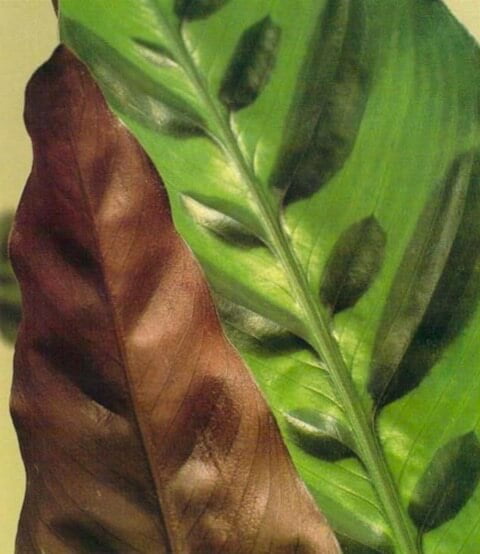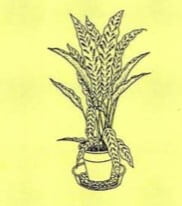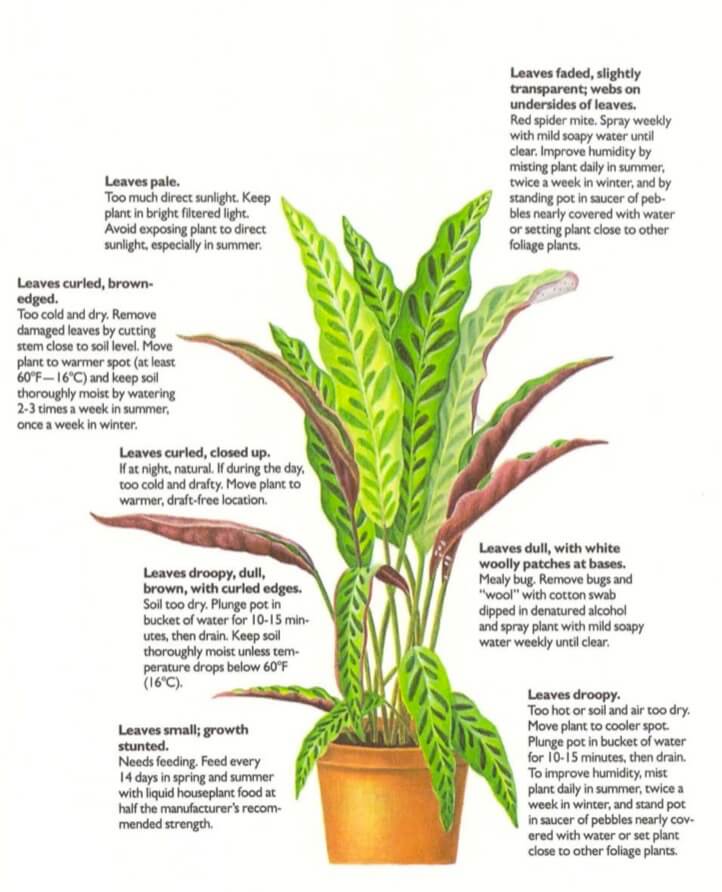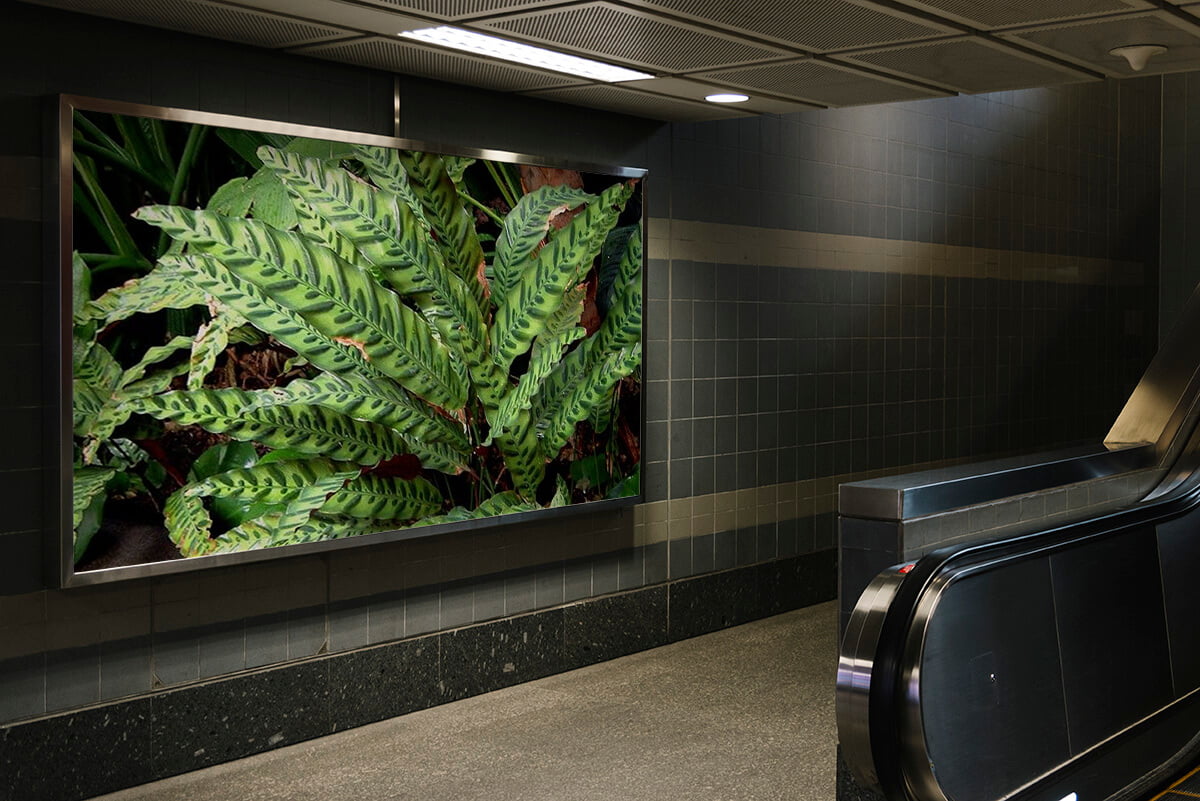[Ebook Việt Hoá] The Instant Guide to Healthy Houseplants (Hướng dẫn tức thời để chăm cây trong nhà khoẻ mạnh), Chi Calathea (Goeppertia) - Chi Đuôi Công
[Ebook Việt Hoá] The Instant Guide to Healthy Houseplants: Calathea insignis (Prayer plant, Rattlesnake plant)
- Nguồn: [Ebook Việt Hoá] The Instant Guide to Healthy Houseplants (Hướng dẫn tức thời để chăm cây trong nhà khoẻ mạnh)
- Biên tập: Dũng Cá Xinh
- Biên dịch: Team Codai.net
English
This is not the easiest houseplant to grow, but it is one of the most beautiful. The patterns on the long, pointed leaves of Calathea insignis appear to be hand painted in delicate shades of green or green and mahogany. The plant’s common name, prayer plant, may derive from the fact that these patterns resemble ones found on Moslem prayer mats, or the name may come from the leaves’ habit of folding like hands in prayer indoors at night. Calathea plants are often confused with plants from another genus, Maranta, whose plants have the same common name and similar leaf patterns. In general, Calatheas are more upright plants than Marantas.

Light
Prefers filtered light. Avoid windows that face the sun in summer.
Temperature
Keep temperature above 60°F (16°C) year-round. Plant will tolerate temperatures as high as 85°F (29°C) if humidity is also high.
Water
Keep soil thoroughly moist by watering 2-3 times a week in summer, once a week in winter. Do not water if temperature drops below 60°F (16°C).
Feeding
During the growing season, feed every 14 days with liqUid houseplant food at half the manufacturer’s recommended strength.
Repotting
Repot annually in spring. When plant outgrows its container, divide plant and repot sections in separate pots.
Soil
Use peat-based soil. A porous mix is best.
Cleaning
Clean by spraying leaves with tepid water or wiping leaves with damp cloth.
Humidity
Maintain high humidity by misting plant daily in summer, twice a week in winter. To provide permanent local humidity, stand pot in saucer of pebbles almost covered with water. Do not allow base of pot to touch the water. Or set plant close to other foliage plants.

What Goes Wrong

- Leaves pale: Too much direct sunlight. Keep plant in bright filtered light. Avoid exposing plant to direct sunlight, especially in summer.
- Leaves curled, brown-edged: Too cold and dry. Remove damaged leaves by cutting stem close to soil level. Move plant to warmer spot (at least 60°F-16°C) and keep soil thoroughly moist by watering 2-3 times a week in summer, once a week in winter.
- Leaves curled, closed up: If at night, natural. If during the day, too cold and drafty. Move plant to warmer, draft-free location.
- Leaves droopy, dull, brown, with curled edges: Soil too dry. Plunge pot in bucket of water for 10-15 minutes, then drain. Keep soil thoroughly moist unless temperature drops below 60°F (16°C)
- Leaves small; growth stunted: Needs feeding. Feed every 14 days in spring and summer with liquid houseplant food at half the manufacturer’s recommended strength.
- Leaves faded, slightly transparent; webs on undersides of leaves: Red spider mite. Spray weekly with mild soapy water until clear. Improve humidity by misting plant daily in summer, twice a week in winter, and by standing pot in saucer of pebbles nearly covered with water or setting plant close to other foliage plants.
- Leaves dull, with white woolly patches at bases: Mealy bug. Remove bugs and “wool” with cotton swab dipped in denatured alcohol and spray plant with mild soapy water weekly until clear.
- Leaves droopy: Too hot or soil and air too dry. Move plant to cooler spot. Plunge pot in bucket of water for 10-15 minutes, then drain. To improve humidity, mist plant daily in summer, twice a week in winter, and stand pot in saucer of pebbles nearly covered with water or set plant close to other foliage plants.
Tiếng Việt
Đây không phải là loại cây dễ trồng nhất, nhưng nó là một trong những loại cây đẹp nhất. Các hoa văn trên lá dài, nhọn của Calathea giống như được vẽ bằng tay với các sắc thái tinh tế của màu xanh lá cây và gỗ gụ. Tên thông thường của loài cây này, cây “cầu nguyện”, có thể bắt nguồn từ việc những mẫu này giống với mẫu được tìm thấy trên thảm cầu nguyện Hồi giáo, hoặc tên có thể xuất phát từ thói quen gập lại của lá giống như bàn tay khi cầu nguyện trong nhà vào ban đêm. Cây Calathea thường bị nhầm lẫn với các cây từ một chi khác, Maranta, có cùng tên chung và các mẫu lá tương tự. Nhìn chung, Calatheas là cây mọc thẳng đứng hơn Marantas.

Ánh sáng
Thích ánh sáng được lọc qua màng. Tránh cửa sổ đối diện với mặt trời vào mùa hè.
Nhiệt độ
Giữ nhiệt độ trên 60 ° F (16 ° C) quanh năm. Cây sẽ chịu được nhiệt độ cao tới 85 ° F (29 ° C) nếu độ ẩm cũng cao.
Nước
Giữ ẩm kỹ cho đất bằng cách tưới nước 2-3 lần một tuần vào mùa hè, một lần một tuần vào mùa đông. Không tưới nước nếu nhiệt độ giảm xuống dưới 60 ° F (16 ° C).
Bón phân
Trong mùa sinh trưởng, bón phân 14 ngày một lần với phân bón hữu cơ nồng độ một nửa so với lượng khuyến cáo của nhà sản xuất.
Thay chậu
Thay chậu hàng năm vào mùa xuân. Khi cây phát triển tốt trong thùng chứa, hãy chia cây và thay vào các chậu riêng biệt.
Đất
Sử dụng đất làm từ than bùn. Tốt nhất là hỗn hợp xốp.
Làm sạch
Làm sạch bằng cách xịt nước ấm lên lá hoặc lau lá bằng khăn ẩm.
Độ ẩm
Duy trì độ ẩm cao bằng cách phun sương cho cây hàng ngày vào mùa hè, hai lần một tuần vào mùa đông. Để tạo độ ẩm lâu dài, hãy đặt chậu trong một đĩa sỏi gần như phủ đầy nước. Không để đế chậu tiếp xúc với nước. Hoặc đặt cây gần các cây có tán lá khác.

Những vấn đề có thể xảy ra

- Lá nhợt nhạt: Quá nhiều ánh nắng trực tiếp. Giữ cây trong ánh sáng lọc qua màng. Tránh để cây tiếp xúc trực tiếp với ánh nắng mặt trời, đặc biệt là vào mùa hè.
- Lá xoăn, viền nâu: Quá lạnh và khô. Loại bỏ các lá bị hư hại bằng cách cắt bỏ thân cây gần với mặt đất. Di chuyển cây đến nơi ấm hơn (ít nhất 60 ° F-16 ° C) và giữ ẩm kỹ cho đất bằng cách tưới nước 2-3 lần một tuần vào mùa hè, một tuần một lần vào mùa đông.
- Lá quăn, khép lại: Nếu vào ban đêm thì là tự nhiên. Nếu vào ban ngày, quá lạnh và nhiều gió. Di chuyển cây đến vị trí ấm hơn, không có gió lùa.
- Lá rũ xuống, xỉn màu, nâu, mép cuộn lại: Đất quá khô. Ngâm chậu trong xô nước khoảng 10-15 phút, sau đó để ráo. Giữ đất ẩm hoàn toàn trừ khi nhiệt độ giảm xuống dưới 60 ° F (16 ° C)
- Lá nhỏ; còi cọc: Cần bón phân. Bón phân 14 ngày một lần vào mùa xuân và mùa hè với phân bón hữu cơ dạng lỏng với liều lượng bằng một nửa so với khuyến nghị của nhà sản xuất.
- Lá nhạt màu, hơi trong suốt; mạng nhện ở mặt dưới lá: Nhện đỏ. Xịt hàng tuần bằng nước xà phòng nhẹ cho đến khi sạch. Cải thiện độ ẩm bằng cách phun sương cho cây hàng ngày vào mùa hè, hai lần một tuần vào mùa đông và bằng cách đặt chậu cây trong đĩa sỏi gần như phủ đầy nước hoặc đặt cây gần các cây có tán lá khác.
- Lá xỉn màu, có những mảng lông tơ màu trắng ở gốc: Rệp sáp. Loại bỏ bọ và “mảng lôn tơ” bằng tăm bông nhúng vào cồn biến tính và xịt cây bằng xà phòng nhẹ hàng tuần cho đến khi sạch.
- Lá rũ xuống: Quá nóng hoặc đất và không khí quá khô. Di chuyển cây đến chỗ mát hơn. Ngâm chậu trong xô nước khoảng 10-15 phút, sau đó để ráo. Để cải thiện độ ẩm, tưới cây phun sương hàng ngày vào mùa hè, hai lần một tuần vào mùa đông, và đặt chậu trong đĩa sỏi gần như phủ đầy nước hoặc đặt cây gần các cây có tán lá khác.



